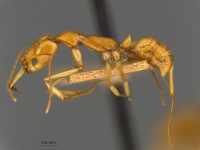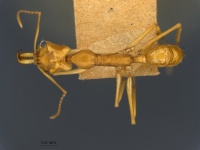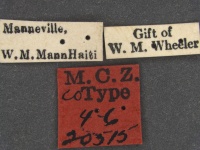Anochetus haytianus
| Anochetus haytianus | |
|---|---|

| |
| Scientific classification | |
| Kingdom: | Animalia |
| Phylum: | Arthropoda |
| Class: | Insecta |
| Order: | Hymenoptera |
| Family: | Formicidae |
| Subfamily: | Ponerinae |
| Tribe: | Ponerini |
| Genus: | Anochetus |
| Species: | A. haytianus |
| Binomial name | |
| Anochetus haytianus Wheeler, W.M. & Mann, 1914 | |
Known only from eastern Haiti. The types were collected from small colonies under rocks in shady places. Brown (1978) believed they are likely to be nocturnal foragers.
Identification
Summarized from Brown (1978): Distinguished from other emarginatus group species by its shorter mandibles (MI < 67) with fewer teeth and denticles along the inner preapical margins. More or less yellow in color. Distinguished from the similar Anochetus longispinus by its acute petiole teeth that are < .01 mm long.
Keys including this Species
Distribution
Latitudinal Distribution Pattern
Latitudinal Range: 18.64° to 18.64°.
| North Temperate |
North Subtropical |
Tropical | South Subtropical |
South Temperate |
- Source: AntMaps
Distribution based on Regional Taxon Lists
Neotropical Region: Greater Antilles, Haiti (type locality).
Distribution based on AntMaps
Distribution based on AntWeb specimens
Check data from AntWeb
Countries Occupied
| Number of countries occupied by this species based on AntWiki Regional Taxon Lists. In general, fewer countries occupied indicates a narrower range, while more countries indicates a more widespread species. |

|
Estimated Abundance
| Relative abundance based on number of AntMaps records per species (this species within the purple bar). Fewer records (to the left) indicates a less abundant/encountered species while more records (to the right) indicates more abundant/encountered species. |

|
Biology
|
Castes
Nomenclature
The following information is derived from Barry Bolton's Online Catalogue of the Ants of the World.
- haytianus. Anochetus (Stenomyrmex) haytianus Wheeler, W.M. & Mann, 1914: 15, fig. 6 (w.) HAITI.
- Type-material: syntype workers (number not stated, “a number of specimens”).
- [Note: Baroni Urbani, 1973b: 143, cites 1w syntype (as ‘paratype’) NHMB.]
- Type-localities: Haiti: Manneville, W shore Lake Assuei, 1912-13 (W.M. Mann) (invalid restriction of type-locality by Kempf, 1972a: 22; no lectotype designated), Haiti: Mts N of Jacmel, 1912-13 (W.M. Mann).
- Type-depositories: MCZC, NHMB.
- Status as species: Wheeler, W.M. 1925a: 9 (in key); Kempf, 1964f: 238; Kempf, 1972a: 22; Brown, 1978c: 557, 611; Bolton, 1995b: 64; Lubertazzi, 2019: 72.
- Distribution: Haiti.
Unless otherwise noted the text for the remainder of this section is reported from the publication that includes the original description.
Description
Worker
Length 6.5-7.5 mm.
Differing from emarginatus Fabr. in the following structural characters: The head is much broader behind, the mandibles shorter, with fewer (4 to 5) denticles on their inner borders and slightly shorter apical teeth. The antennal scapes and all the funicular joints are distinctly shorter, the former extending less than one quarter their length beyond the posterior corners of the head. The epinotum is quite unarmed, low and rounded in profile. The petiole is more erect, with subequal anterior and posterior declivities and at the summit with two teeth which are longer, more acute and more diverging than in emarginatus.
Body smooth and shining; pronotum finely and longitudinally, meso- and epinotum more coarsely and transversely rugose; front of head also finely longitudinally rugose, the rugae diverging posteriorly.
Hairs very sparse as in emarginatus and confined to the mouth and gaster.
Color brownish yellow, legs, mandibles and antennae paler, the tint throughout being lighter than in emarginatus subsp. testaceus Forel.
Type Locality Information
Described from a number of specimens taken at Manneville and in the mountains north of Jacmel from small colonies nesting under stones in shady places.
References
- Brown, W. L., Jr. 1978c. Contributions toward a reclassification of the Formicidae. Part VI. Ponerinae, tribe Ponerini, subtribe Odontomachiti. Section B. Genus Anochetus and bibliography. Studia Entomologica. 20:549-638. (page 611, see also)
- Lubertazzi, D. 2019. The ants of Hispaniola. Bulletin of the Museum of Comparative Zoology, 162(2), 59-210 (doi:10.3099/mcz-43.1).
- Wheeler, W. M.; Mann, W. M. 1914. The ants of Haiti. Bull. Am. Mus. Nat. Hist. 33: 1-61 (page 15, fig. 6 worker described)
References based on Global Ant Biodiversity Informatics
- Brown Jr., W.L. 1978. Contributions toward a reclassification of the Formicidae. Part VI. Ponerinae, Tribe Ponerini, Subtribe Odontomachiti, Section B. Genus Anochetus and Bibliography. Studia Entomologia 20(1-4): 549-XXX
- Brown W.L. Jr. 1978. Contributions toward a reclassification of the Formicidae. Part VI. Ponerinae, tribe Ponerini, subtribe Odontomachiti. Section B. Genus Anochetus and bibliography. Studia Ent. 20(1-4): 549-638.
- Fernández F. 2008. Subfamilia Ponerinae s.str. Pp. 123-218 in: Jiménez, E.; Fernández, F.; Arias, T.M.; Lozano-Zambrano F. H. (eds.) 2008. Sistemática, biogeografía y conservación de las hormigas cazadoras de Colombia. Bogotá: Instituto de Investigación de Recursos Biológicos Alexander von Humboldt, xiv + 609 pp.
- Kempf W. W. 1964. The ants of the genus Anochetus (Stenomyrmex) in Brazil (Hym., Formicidae). Studia Entomologica 7: 237-246.
- Kempf, W.W. 1972. Catalago abreviado das formigas da regiao Neotropical (Hym. Formicidae) Studia Entomologica 15(1-4).
- Lubertazzi D. 2019. The ants of Hispaniola. Bulletin of the Museum of Comparative Zoology, 162(2): 59-210.
- Perez-Gelabert D. E. 2008. Arthropods of Hispaniola (Dominican Republic and Haiti): A checklist and bibliography. Zootaxa 1831:1-530.
- Scott-Santos, C.P., F.A. Esteves, C.R.F. Brandao. 2008. Catalogue of "Poneromorph" ant type specimens (Hymenoptera, Formicidae) deposited in the Museu de Zoologia da Universidade de Sao Paulo, Brazil. Papeis Avulsos de Zoologia 48(11):75-88.
- Wheeler W. M., and W. M. Mann. 1914. The ants of Haiti. Bulletin of the American Museum of Natural History 33: 1-61.


